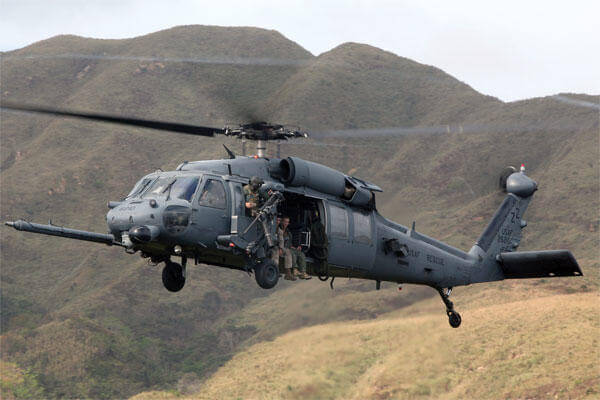One U.S. Special Operations soldier was killed, two others were wounded and a medevac helicopter went down in ongoing action Tuesday to take back territory from a resurgent Taliban in Afghanistan's southwestern Helmand province, the U.S. military said.
The fighting near Marja, which was the center of the Taliban's drug operations before a major Marine offensive in 2010, highlighted the "continuing risk" to U.S. and coalition forces in their mission to train, advise and assist Afghan troops, according to Pentagon Press Secretary Peter Cook.
Two Air Force Special Operations HH-60 Pave Hawk helicopters were sent to evacuate the Americans from the Marja firefight but neither was able to carry out the mission, Cook said. One was waved off, possibly because of enemy ground fire, and the second went down after apparently hitting a rotor blade off the wall of an Afghan compound.
Cook could not confirm reports that the second helicopter was also hit on the ground by enemy mortar fire or whether there were additional casualties aboard that helicopter. Cook also could not confirm whether the U.S. casualties had been evacuated from the scene, but added, "I'm not aware of anyone that's not been accounted for."
"There's fighting on the ground as we speak," Cook said at a Pentagon news conference, and it was difficult to provide details on the Marja action that occurred as U.S. Special Operations forces came to the aid of Afghan Special Forces.
A statement from Brig Gen. Wilson Shoffner, a spokesman for U.S. Forces-Afghanistan in Kabul, said, "One U.S. service member died as a result of wounds sustained during operations near Marja in Helmand Province today" and two others were wounded.
On behalf of Army Gen. John Campbell, commander of U.S. and coalition forces in Afghanistan, and all U.S. troops in Afghanistan, "our heartfelt sympathies go out to the families and friends of those involved," Shoffner said.
The death of the soldier near Marja was the first combat fatality for the U.S. in Afghanistan in 2016 and came amid a series of setbacks and mounting casualties for the Afghan National Security Forces, a wave of bombings in Kabul and the "emergent threat" from the Islamic State of Iraq and Syria in southeastern Afghanistan.
Last year, 27 coalition troops died in Afghanistan, including 22 Americans. That was the lowest casualty total for U.S. and coalition forces since 2002.
Despite the growing Taliban threat, Defense Secretary Ashton Carter had no plans to change the train, advise and assist mission or increase the number of U.S. troops, Cook said. "We believe we're on the right course," Cook said, while acknowledging "this has been a difficult day."
Western media reports said that the action in Marja came in an operation in which the Afghan forces were seeking to reopen the road between Marja and the provincial capital of Lashkar Gah to the northeast in Helmand.
Heavy fighting to the north in the Sangin district, which was a frequent battleground for the Marines, had threatened the fall of Lashkar Gah, once the headquarters for British operations in the region.
Combat operations for U.S. forces ended in 2014 and President Barack Obama's plan had been to reduce the number of American troops there to about 1,000 by the end of 2016. However, Obama later went along with Gen. Campbell's recommendation to keep the troop strength at about 9,800 through 2015 while aiming to reduce forces to about 5,000 by the end of 2016.
In a Dec. 30 interview with USA Today, Campbell said he might ask for additional forces if Afghan National Security Forces attempts to beat back the Taliban offensives fail.
"If I don't believe that we can accomplish the train, advise and assist and the (counter-terrorism) missions, then I owe it to the senior leadership to come back and say, 'Here's what I need.' If that's more people, it's more people," Campbell said.
"There is reason to hope, despite it all" in Afghanistan, Brookings Institution military analyst Michael O'Hanlon said Monday at a forum on the future of Afghanistan. He cited a recent survey by the Asia Foundation showing that Afghans had a "greater fear" about the country's future but also "expressed high confidence in their army and police."
Vanda Felbab-Brown, a Brookings senior fellow, noted the impact of the "brain drain" on Afghanistan's development as more and more young Afghans give up on their prospects at home and flee the country. About 70,000 mostly young Afghans left last year and made up the fifth largest group of refugees seeking to gain permanent homes in Europe, Felbab-Brown said.
While acknowledging the military threat posed by the Taliban, Felbab-Brown said that "politics are really at the core of Afghanistan's troubles" as regional powerbrokers and former President Hamid Karzai continue to undercut each other.
She predicted another year of turmoil in 2016 marked by a "continuing dire economic situation, outflow of people, a major Taliban push and a political system stuck in infighting."
-- Richard Sisk can be reached at Richard.Sisk@military.com.

























